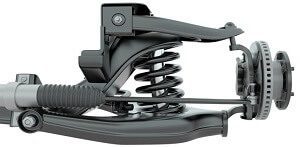How Much Does Control Arm Bushings Replacement Cost?
Last Updated on July 2, 2025
Written by CPA Alec Pow | Content Reviewed by ![]() CFA Alexander Popinker
CFA Alexander Popinker
Our data shows control arm bushings fail on roughly one in six vehicles past 90 000 miles, making the replacement cost a frequent Google search. These small rubber or polyurethane sleeves isolate suspension noise, absorb road vibration, and hold wheel alignment steady. Once they crack or tear, steering wander, clunking noise, and tire-edge wear follow fast.
Drivers who research repair pricing want two things: an honest estimate before handing keys to any mechanic, and leverage to avoid hidden shop fees. Knowing how parts, labor, and add-ons stack up lets owners choose between dealer service, an independent shop, or a Saturday DIY in the driveway.
Below we break down typical price brackets, real invoices, an item-by-item cost table, plus expert pointers on warranty and brand choice. Readers see exactly where the money goes and how to shave 15 % or more off the final bill.
Article Highlights
- Typical control arm bushing replacement runs $175 (≈1.5 days working without breaks at $15/hour)–$427 (≈3.6 days of desk time at a $15/hour wage); luxury or full-arm jobs climb past $1,000 (≈1.7 weeks working every single day at $15/hour).
- Labor dominates the bill, often 60 % of total cost.
- Polyurethane bushings cost more up front but last longer, cutting lifetime spend.
- Alignments add $70 (≈4.7 hours to sacrifice at work earning $15/hour)–$120 (≈1 day working for this purchase at $15/hour) yet prevent tire wear—skip at your wallet’s peril.
- Coupons, bundled repairs, and DIY press rentals trim 15 %-25 % off shop quotes.
- OEM parts carry longer warranties; aftermarket saves cash but watch brand quality.
How Much Does Control Arm Bushings Replacement Cost?
We found three clear tiers. Budget jobs on compact sedans run $175 (≈1.5 days working without breaks at $15/hour) – $233 (≈1.9 days of labor continuously at a $15/hour wage) total, with parts cost at $15 (≈1 hour of uninterrupted labor at $15/hour) – $50 (≈3.3 hours of labor required at $15/hour) and labor cost near $145 (≈1.2 days working to pay for this at $15/hour) – $180 (≈1.5 days working every waking hour at $15/hour). Mid-range family SUVs land between $308 (≈2.6 days of labor to afford this at $15/hour) – $427 (≈3.6 days of desk time at a $15/hour wage), driven by extra arm length and bushing press time. Luxury or heavy-duty trucks requiring hydraulic presses or specialty polyurethane sleeves reach $500+ (≈4.2 days of your career at $15/hour), and complete control arm swaps climb to $600 (≈1 week of salary time at $15/hour) – $1,000 (≈1.7 weeks working every single day at $15/hour).
Labor usually outweighs components. A press-out, press-in job books 1.2–2.0 flat-rate hours; at a national average $95 (≈6.3 hours working without breaks at $15/hour) shop rate, that’s $114 (≈7.6 hours working without breaks at $15/hour) – $190 (≈1.6 days of your career at $15/hour) just for wrench time. Parts price rises when owners pick OEM rubber at the dealership—about $60 (≈4 hours to sacrifice at work earning $15/hour)–$120 (≈1 day working for this purchase at $15/hour)—versus aftermarket polyurethane from Prothane or Energy Suspension at $25 (≈1.7 hours of labor required at $15/hour)–$65 (≈4.3 hours that you sacrifice at a $15/hour job).
Warranty influences quotes. Dealers bundle 12-month parts coverage into the sticker, while independents match parts maker terms (often 90 days). Insurance seldom covers wear, so out-of-pocket payment remains the norm.
According to AutoNation Mobile Service, parts usually cost between $100 and $120 (≈1 day working for this purchase at $15/hour), while labor ranges from $100 to $300 (≈2.5 days of labor continuously at a $15/hour wage). The total cost depends on the vehicle and the mechanic’s rates.
RepairPal estimates the cost between $308 and $427 (≈3.6 days of desk time at a $15/hour wage), with labor costs from $202 to $297 (≈2.5 days of your career at $15/hour) and parts priced between $106 and $130 (≈1.1 days of your career at $15/hour). This estimate can vary based on location and vehicle model.
Many shops prefer to replace the entire control arm instead of just the bushings because it is often easier and more cost-effective. A Reddit discussion on r/FordFocus highlights that replacing both lower control arms can cost around $900 to $1,100 (≈1.8 weeks of your career at a $15/hour job), including parts and labor, which some consider a better long-term investment.
Labor-intensive repairs such as replacing just the bushings may cost more in labor hours compared to swapping the entire control arm. For example, Rick’s Free Auto Repair Advice explains that dealer labor rates can push the total cost to over $700 (≈1.2 weeks of salary time at $15/hour) per side when replacing bushings alone, while independent shops might charge around $530 per side.
Real-Life Cost Examples
A Boston driver replaced front lower bushings on a 2016 Honda Civic at an independent repair shop. Parts: Moog rubber sleeves $42. Labor: 1.4 hours at $110/hour = $154. Disposal and shop-supply fee $12. Alignment voucher $79. Invoice total: $287.
A Denver Jeep Grand Cherokee owner used a dealership. OEM arms came pre-loaded with bushings and ball joints: $672 for both sides. Labor clocked two hours at $145 each. Alignment: $99. Tax and haz-waste fee $18. Grand total: $1,079—nearly four times the Civic job.
One DIYer in Phoenix pressed polyurethane Whiteline sleeves into a 2009 Mazda3. Parts plus loan-a-tool set $58. Weekend labor = personal time. Alignment coupon $69. Total cash outlay $127 (give or take a few dollars), though the owner noted a typo in torque spec—tightened twice after a squeak appeared.
You might also like our articles on the cost of spun bearing repair, shocks and struts replacement, or car chassis repair.
Cost Breakdown
|
Cost Item |
Low Price |
High Price |
Notes |
|
Bushings (pair) |
$15 |
$120 |
Rubber lower; poly upper |
|
Labor (1.2–2 hr) |
$114 |
$290 |
Based on $95–$145 rate |
|
Shop supplies |
$5 |
$18 |
Gloves, sealant, cleaners |
|
Disposal / haz fee |
$0 |
$15 |
State-mandated in some regions |
|
Wheel alignment |
$70 |
$120 |
Required to protect tires |
|
Taxes |
$5 |
$30 |
Varies by county |
Parts make up about 35 % of the average repair cost, labor and alignment most of the rest. Shops sometimes add diagnostic scans ($40–$60) if suspension noise needed confirmation before work started.
Factors Influencing the Cost
 Material choice matters first. Basic rubber offers stock ride comfort but averages a five-year lifetime; polyurethane lasts longer, tightens handling, yet costs up to 60 % more and transmits extra vibration.
Material choice matters first. Basic rubber offers stock ride comfort but averages a five-year lifetime; polyurethane lasts longer, tightens handling, yet costs up to 60 % more and transmits extra vibration.
Vehicle design drives labor. Transverse leaf setups on Corvettes need sub-frame drops, doubling wrench hours. Front-wheel-drive compacts use stamped steel arms accessible in minutes. Rust level alters time too—Midwest salt chews bolts, forcing torch work.
Brand impacts parts price. OEM sleeves from Lemförder or ACDelco retail higher yet include precise durometer specs; budget Dorman kits cost less but carry shorter warranty. Supply-chain swings post-2020 inflated synthetic rubber costs about 8 %, pushing all aftermarket tags upward.
Regional labor rate variation tops 50 %. A rural Alabama shop charges $85 per hour; San Francisco dealers post $200. Alignments follow the same map.
Alternative Products or Services
- Bushing-only replacement: Lowest price, keeps factory arms, but presses can mar metal if mishandled.
- Complete control arm assembly: $400 – $1,000 installed; includes ball joint and fresh hardware, saves future duplicate labor.
- DIY repair kits: Poly sleeves, press adapters, and lube combo $45 – $90; perfect for shade-tree mechanics with jack stands.
- Mobile mechanic service: Adds convenience fee $40–$75, yet hourly labor often under dealership rates.
Owners balancing short-term cost with long-term durability frequently select full arms when mileage tops 150 000 mi.
Ways to Spend Less
We found online coupon codes from RockAuto trim parts cost 5–10 %. Pairing repairs—bushings plus brake pads—earns bundled labor discounts at many shops. Off-season promos in February or August knock $20–$40 off alignments.
Aftermarket brands like Mevotech provide pre-assembled arms $60 below OEM, while still supplying a three-year warranty. Salvage-yard arms tempt at $40 each, but hidden bushing wear often nullifies savings.
DIY remains the top savings path if owners already own a press and torque wrench. Renting tools from auto-parts chains for a $0 deposit turns bushing swap into a $50–$90 weekend project.
Expert Insights
Dr. Leonid Varga – Automotive Materials Engineer: “Poly bushings raise initial price about 40 % but double design life; on fleet vehicles they pay back in 18 months through tire and alignment retention.”
Cheryl Osei – Master Technician, Atlanta: advises checking ball-joint play first: “If joints show 1 mm slop, replace the whole control arm. You save a second labor cost six months later.”
Miguel R. Sandhu – Independent Shop Owner, Seattle: sees warranty misreads weekly: “Customers think lifetime means labor, too. Most parts houses cover only material. Expect to pay labor again if bushings fail early.”
Janet Moya – Insurance Adjuster: notes policies rarely reimburse wear parts: “Comprehensive covers collision damage, not squeaky bushings. Budget from pocket.”
Answers to Common Questions
Do both front bushings need replacement at the same time?
Most mechanics recommend pairs to keep suspension geometry identical and avoid a second alignment fee.
Is driving with worn bushings dangerous?
Yes. Excess play alters alignment, increasing tire wear and braking distance.
Can I press bushings without removing the control arm?
Some trucks allow on-car presses, but clear access is rare; full arm removal ensures correct seating.
How long do new rubber bushings last?
Expect 60 000–90 000 miles under normal conditions; harsh climates shorten that span.
Will aftermarket polyurethane void my warranty?
Only if factory policy specifies OEM parts. Check your coverage terms before an upgrade.

Leave a Reply
Want to join the discussion?Feel free to contribute!